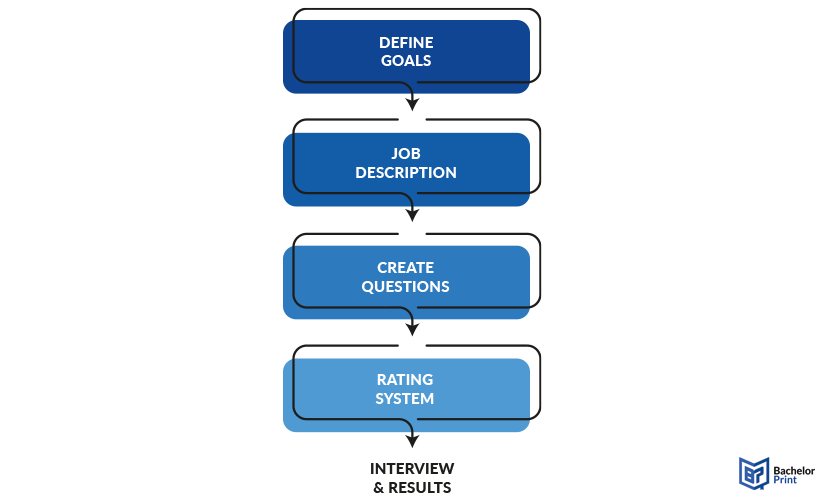
Interviews, especially for jobs, can feel very subjective and sometimes even unfair if the interviewer is free in their choice of questions. A methodology to avoid this conflict is the structured interview, where the same set of questions is asked to each participant to ensure equality. The following article will explain how a structured interview works, which steps to consider while planning one, and what advantages and disadvantages it can have.
Definition: Structured interview
A structured interview is an interview technique mostly used for job interviews. It is, however, not about where it is used but about the method and level of planning it includes. A structured interview consists of a set number of questions, which are predetermined. The goal is to have a uniform set of questions to ensure equal treatment for every interviewee. The questions themselves do not necessarily have to be answered with “yes” or “no,” but are often open to individual answers.
Printing Your Thesis With BachelorPrint
- High-quality bindings with customizable embossing
- 3D live preview to check your work before ordering
- Free express delivery
Configure your binding now!
How to conduct a structured interview
The following are the five main steps entailed in the structured interview process:
Step 1: Define your goals and objectives
The first step of conducting a structured interview is to set the goals and expectations. What do you expect from your employee? What skills should they have? It is also important to include the whole team in this step because hiring managers may have different perspectives than the coworkers of the future employee.
Step 2: Formulate the job description
The next step is the job description you put online. With this, you set the base requirements the applicants need to have and show them what your expectations are.
Step 3: Create the questions
Now you can phrase the questions you want to ask in the structured interview. They can be general or very specific, depending on the topic. Usually, you would have 1-2 questions per job requirement.
It is important to be clear in what you are asking to avoid miscommunication and to not lead the applicants to specific answers. Furthermore, be careful to ask only things that are related to the job and even include possible follow-up questions, so you do not need to make questions up during the interview.
Step 4: Choose a rating system
Usually, you use a scale of 1-5 to rate the answers of the applicants, but you can also make a scale of “excellent” – “terrible.” The scorecard is best created in the process of formulating the job description to avoid discrepancies in the expectations.
Step 5: Conduct the interview and check results
Now you will have to perform the structured interview. Make sure you use only the previously noted questions, even for follow-up ones. Otherwise, your interview will not be equal anymore, and the results will be affected.
It may be best to start the interview with an introduction of the company to break the ice. Then make sure to stick to the script and check your biases during this time. Reflect on what gives you the impression you have on that person and if it is more than just a gut feeling. Also take notes during the interview to avoid having things memorized wrong or biased, also called recall bias.
Lastly, exchange your opinion with the other interviewers to double-check your impressions.

Pros and cons of a structured interview
Although structured interviews provide a clearer and streamlined process of candidate comparison, some pros and cons exist with this interview methodology.
Benefits of a structured interview are:
-
- Increases credibility and validity. Using the same questions for everyone ensures equality and fairness, as well as avoids feelings of mistreatment among the applicants. The results of all applicants can be compared at the end of the structured interview, as everyone is rated by the same system.
- The questions determine how they would perform on the job. Structured interviews mostly include skill-oriented questions and thus focus on how capable they are for the job instead of building on personal preferences.
- Fixed questions reduce discrimination. With questions focusing on skill, cultural or ethnical differences are not relevant. This makes every structured interview more equal and transparent.
- It saves time and costs. Using the same set of questions for every applicant saves the hiring managers a lot of time figuring out new questions, and they can even profit from using them for possible hirings in the future.
- It gives confidence to the applicants. Knowing that they will be going through a structured interview, the applicants will feel more safe and well treated, as interviewer biases cannot determine the final result as easily.
Disadvantages of a structured interview include:
-
- Limited flexibility. Once you select the fixed questions, you no longer have the power to change them without losing the equality of the interviews.
- Limited scope. Whenever a question is close-ended, that interview has a limited scope. The participants don’t have space to expound on their answers or provide additional information.
- The questions are too formal. The formality of the questions doesn’t allow the participants and the interviewers to build a connection. The formal nature of the questions may cause the participants to become uncomfortable or tense, affecting their answers.
- Missing out on the personality. Of course, the interviewer also watches the behavior of the applicant, but as almost all questions are focused on skill and suitability alone, there is no room for a connection between interviewer and interviewee. Occasionally, an applicant may seem too timid for a job or too inexperienced, but they are a quick learner who would fit better into the team.
Analysis of a structured interview
Once you finish conducting your structured interviews, analyze your results. First, give your participants a pseudonym or number for organization purposes and transcribe the recordings using software or manually. Then, conduct a thematic or content analysis to search for patterns or groups in responses.
The analysis should be as follows:
Transcribe your interviews
You will have to transcribe audio-recorded interviews and add transcriptions to the appendix of your paper. When laughter, pauses, or filler words like “mmm” affects your conclusions, use verbatim transcription and include these fillers.
However, use intelligent verbatim transcription if your interviews don’t have these fillers, making them easier to analyze. The transcription process helps cleanse your data, identify errors, and resolve inconsistencies.
Code and analyze your interview
Now you will have to conduct a content or thematic-based analysis of your structured interviews; you may use words, patterns, codes, or themes to separate the responses into categories.
Closed-ended questions usually lead to content analysis, conducted in the following way:
- Count the occurrences of the phrases, concepts, subjects, or words to quantify the categories chosen during the coding stage.
- Organize and summarize the information using descriptive analysis after coding.
- Use inferential statistics to conclude your hypothesis and make future predictions.
Structured interviews in research
Structured interviews can also be used in academic writing, especially when doing research, maybe for your bachelors’ thesis. After getting the findings from your structured interview, combine the results in a research paper. The results sections and discussion areas of your research paper highlight the number of occurrences of your coded groups. In the methodology section, explain the technique you used to collect your data and conceptualize your analysis. In the end, you compare the results to your hypothesis from the beginning and see if they justify or reject it.
Methods for interviews
Before conducting your structured interview, it is important to set how you want to do it. There are three options, on the phone, via videochat or in person. Each of these methods has their benefits and disadvantages, listed below.
| Pro | Con | |
| On the phone | Participants may talk more open when they do not see the interviewer. | You cannot see your participant's expressions and behavior. |
| Videochat | Participants are at home, in their comfortable environment. | If the connection to the internet is weak, you might miss important information. |
| In person | You can see their expressions and body language. | High risk of the interviewer effect. |
The interviewer effect describes the phenomenon, when the participant feels the need to answer a question with what they think the interviewer would like to hear. This leads to untruthful answers and warps the results of the study.
When you need interview recordings for later transcriptions, always make sure to get written consent from your participants.
Types of interviews
During recruitment, you must research and choose the ideal interview form. The table below highlights the similarities and differences between a structured interview, a semi-structured interview, and an unstructured interview.
| Structured interviews | Semi-structured interviews | Unstructured interviews | |
| Fixed Questions | Yes | Yes | No |
| Fixed Order of Questions | Yes | No | No |
| Fixed Number of Questions | Yes | No | No |
| The Option to Ask Additional Questions | No | Yes | Yes |
FAQs
The structured interview is characterized by the fact that all the questions are determined before the interview, so every participant gets the exact same set of questions.
The four major interview types are structured, semi-structured, unstructured, and focus group interviews.
Since everyone gets asked the same questions, those tend to be rather simple like Yes/No ones:
- Are you satisfied with the customer service?
- Do you smoke?
Other Questions may be more open, but they are risky since they can cause misunderstandings and may afford follow-up questions, which are not planned:
- What is your opinion on K-pop?
- Where do you want to travel and why?
Recall bias happens when the interviewer remembers the interview again and recalls some information wrong. This leads to a wrong impression in the mind of the interviewer, that eventually results in bias.
Structured interviews have two main benefits: every applicant gets the same questions, which ensures equality, and it saves time and costs for the interviewer, who does not have to make up new questions in every interview.
